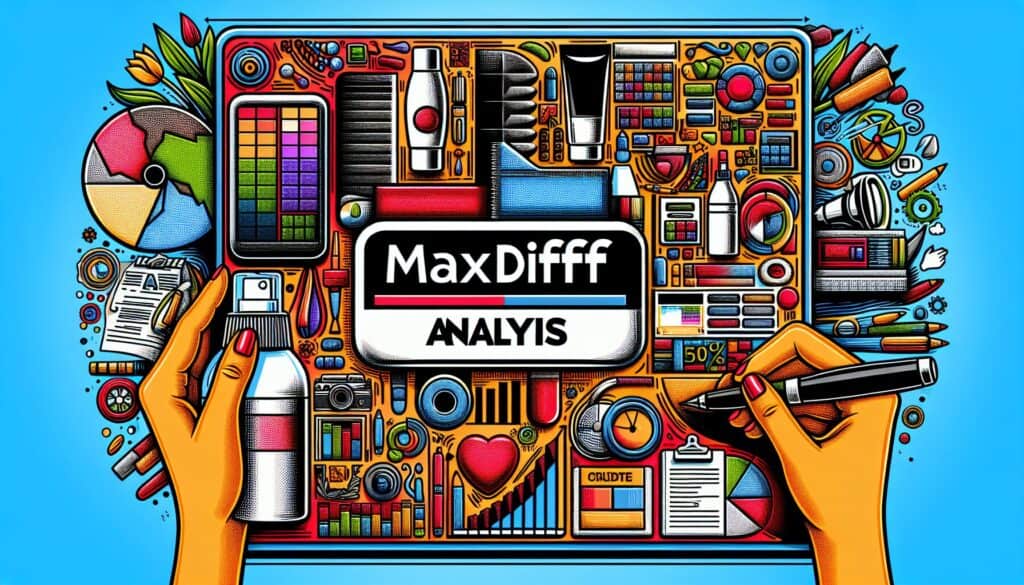A market research technique used to measure the relative preference or importance of a set of items (e.g., product features, brand names, marketing messages).
- Methodologies: Customers & Marketing, Economics, Lean Sigma, Manufacturing, Project Management, Quality
MaxDiff Analysis (Maximum Difference Scaling)

MaxDiff Analysis (Maximum Difference Scaling)
- Agile Methodology, Customer Experience, Design Thinking, Market Research, Product Development, Product Management, Statistical Analysis, User experience (UX), User Interface (UI)
Objective:
How it’s used:
- Respondents are shown subsets of items and asked to indicate which item is the best/most important and which is the worst/least important from the subset. This is repeated with different subsets.
Pros
- Provides a more discriminating measure of importance than simple rating scales; easier for respondents than full ranking of many items; produces interval-scale scores.
Cons
- Can be more cognitively demanding for respondents than simple rating scales; requires specialized software for design and analysis; selection of items to test is critical.
Categories:
- Customers & Marketing
Best for:
- Measuring the relative importance or preference for multiple items (e.g., features, benefits, messages) more effectively than rating scales.
MaxDiff Analysis, or Maximum Difference Scaling, is an advanced methodology particularly valuable in market research and product development across various industries such as consumer goods, technology, healthcare, and services. This technique is especially applicable in the early and middle phases of product design when determining which features or attributes resonate most with target audiences. Teams including product managers, design engineers, marketing strategists, and user experience researchers often collaborate to implement this analysis. It provides a clear framework for respondents to evaluate subsets of product attributes or features, clarifying preferences in a way that traditional rating scales may not effectively capture. This approach is valuable during product iterations and concept testing, as it can influence decisions about which features to prioritize based on quantifiable interval-scale scores derived from user preferences. By leveraging MaxDiff, companies can refine their offerings to meet user expectations while optimizing resource allocation in product development processes. As a result, the method is not only practical for identifying key differentiators in a crowded market but also aids in aligning product strategies with consumer needs. Such an evidence-based approach supports competitive positioning and enhances the likelihood of a successful product launch.
Key steps of this methodology
- Define the items to be evaluated based on research objectives.
- Design subsets of items for presentation to respondents.
- Determine the number of rounds or sets to maintain respondent engagement.
- Implement the selection mechanism for respondents to choose best and worst items.
- Analyze the preferences indicated by respondents across subsets.
- Calculate the scores to determine the relative importance of each item.
- Validate the results through statistical methods to ensure reliability and validity.
Pro Tips
- Utilize randomized subsets to minimize bias and ensure diverse pairwise comparisons while maintaining respondent engagement.
- Incorporate demographic or behavioral segmentation to analyze how preferences differ among various user groups, enhancing the interpretability of results.
- Balance the number of items in each subset to avoid cognitive overload, ensuring clarity and reliability in respondents' choices.
To read and compare several methodologies, we recommend the
> Extensive Methodologies Repository <
together with the 400+ other methodologies.
Your comments on this methodology or additional info are welcome on the comment section below ↓ , so as any engineering-related ideas or links.
Historical Context
1960
1980
1983
1990
1995
2000
2010
1950
1980
1980
1986
1994
1995
2000
(if date is unknown or not relevant, e.g. "fluid mechanics", a rounded estimation of its notable emergence is provided)














Related Posts
Musculoskeletal Discomfort Questionnaires
Multivariate Testing (MVT)
Multiple Regression Analysis
Motion Capture Systems
MoSCoW Method
Mood’s Median Test